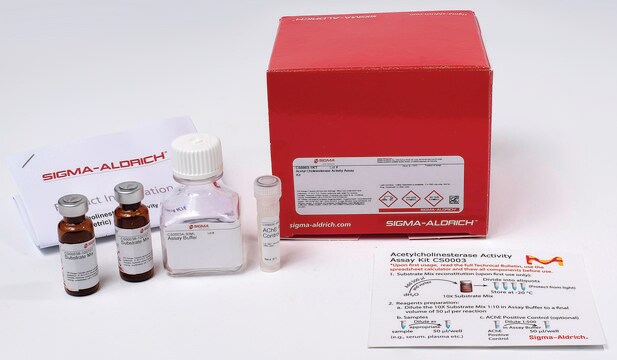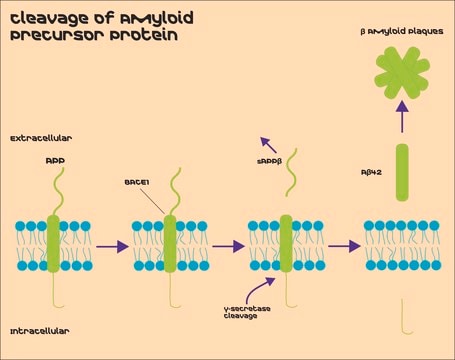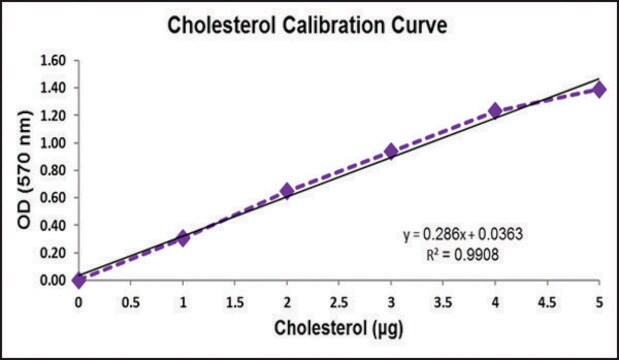MAK119
Acetylcholinesterase Activity Assay Kit
sufficient for 100 colorimetric tests
Sinónimos:
ACHE Activity Assay, RBC Cholinesterase Activity Assay
Iniciar sesiónpara Ver la Fijación de precios por contrato y de la organización
About This Item
Código UNSPSC:
12161503
NACRES:
NA.84
Productos recomendados
uso
sufficient for 100 colorimetric tests
método de detección
colorimetric
enfermedades relevantes
neurological disorders
temp. de almacenamiento
room temp
Información sobre el gen
human ... ACHE(43)
mouse ... ACHE(11423)
Descripción general
Acetylcholinesterases (AChEs) are enzymes that hydrolyze the neurotransmitter acetylcholine (ACh) to acetate and choline. AChE is located at the synaptic cleft and functions to terminate synaptic transmission by catalyzing the breakdown of ACh allowing cholinergic neurons to return to a resting state after activation. It is also found in membranes of red blood cells, motor and sensory fibers, muscles, nerves and central and peripheral tissues. Changes in AChE activity may result from exposure to certain insecticides, which act as cholinesterase inhibitors. Inhibitors of AChE are also used to treat certain conditions such as dementia.
Aplicación
Acetylcholinesterase activity assay kit has been used to determine the activity of acetylcholinesterase in a rat organophosphate model and in brain tissue homogenates.
Características y beneficios
Compatible with high-throughput handling systems. Can be adapted for use with cuvettes.
Idoneidad
Suitable for the detection of acetylcholinesterase activity in biological samples such as blood, serum, and plasma.
Principio
This assay is an optimized version of the Ellman method in which thiocholine, produced by AChE, reacts with 5,5′-dithiobis(2-nitrobenzoic acid) to form an colorimetric (412 nm) product, proportional to the AChE activity present. One unit of AChE is the amount of enzyme that catalyzes the production of 1.0 μmole of thiocholine per minute at room temperature at pH 7.5. This kit has a linear range of 10-600 units/L of AChE activity.
Código de clase de almacenamiento
10 - Combustible liquids
Clase de riesgo para el agua (WGK)
WGK 3
Certificados de análisis (COA)
Busque Certificados de análisis (COA) introduciendo el número de lote del producto. Los números de lote se encuentran en la etiqueta del producto después de las palabras «Lot» o «Batch»
¿Ya tiene este producto?
Encuentre la documentación para los productos que ha comprado recientemente en la Biblioteca de documentos.
Los clientes también vieron
Abdullah M Alzahrani
Environmental science and pollution research international, 26(16), 16548-16555 (2019-04-14)
Despite the widespread use of the insecticide imidacloprid (IMI), a neonicotinoid, there is an urgent need for documenting information related to its acute toxicity. Therefore, this study aims to explore the markers of IMI acute toxicity in the testes of
Study on social isolation as a risk factor in development of Alzheimer?s disease in rats.
Ali A A, et al.
Brain disorders & therapy., 6(230), 2-2 (2017)
Neuroprotective Effects of AEOL10150 in a Rat Organophosphate Model.
Liang L P, et al.
Toxicological Sciences, 162(2), 611-621 (2017)
Zhen-Xing Zuo et al.
Neural plasticity, 2015, 453170-453170 (2015-12-24)
Chronic pain is a major health issue and most patients suffer from spontaneous pain. Previous studies suggest that Huperzine A (Hup A), an alkaloid isolated from the Chinese herb Huperzia serrata, is a potent analgesic with few side effects. However
Marine Droguerre et al.
Frontiers in neuroscience, 14, 563-563 (2020-07-03)
Donepezil (DPZ) is an acetylcholinesterase inhibitor used in Alzheimer's disease to restore cognitive functions but is endowed with limited efficacy. Recent studies pointed out the implication of astroglial networks in cognitive processes, notably via astrocyte connexins (Cxs), proteins involved in
Nuestro equipo de científicos tiene experiencia en todas las áreas de investigación: Ciencias de la vida, Ciencia de los materiales, Síntesis química, Cromatografía, Analítica y muchas otras.
Póngase en contacto con el Servicio técnico






